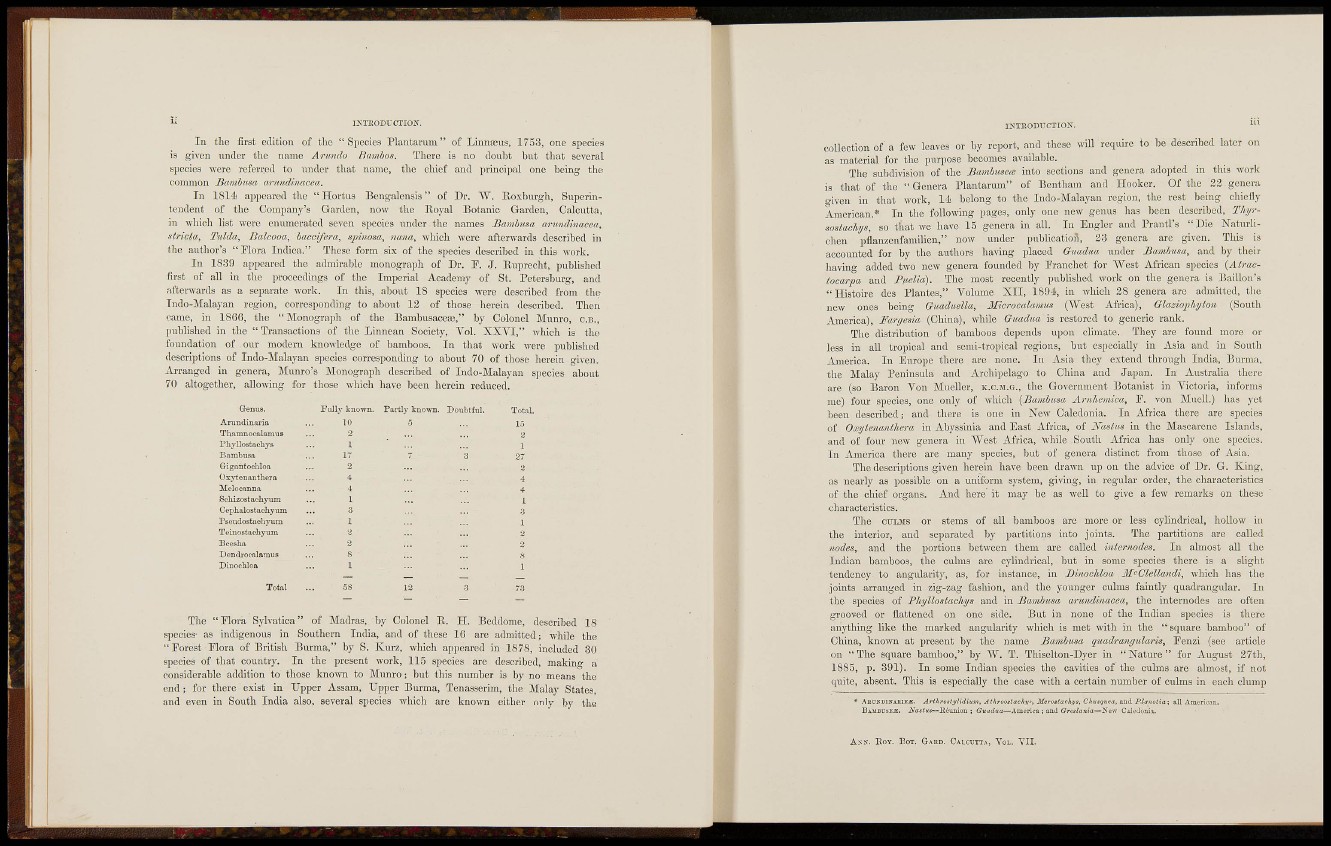
l i I^•T^xODUCTIO^'•.
In tlie first edition of the "Species Plantamm" of Linnaeus, 1753, one spccies
is given under the name Arundo Bambos. There is no doubt but that several
species •^^'ere referred to under tliat name, the chief and principal one being the
con^mon Bamhnsa arumUnacea.
In 181-i appeared the "Hortus Bengalensis" of Dr. W, Koxburgh, Superintendent
of the Company's Garden, now the Eoyal Botanic Garden, Calcutta,
in which, list were enumerated seven species under the names Bamhma aimndinacea,
utricta, Ttdda, Balcooa, haccifera, spinosa, nana, which "were aftewvards described in
the author's "Tlora Indica." These form six of the species described in this work.
In 1830 appeared the admirable monograph of Dr. F. J. Euprecht, pubhshecl
first of all in the proceedings of the Imperial Academy of St. Petersburg, and
afterwards as a separate work. In this, about 18 species were described from the
Indo-Malaj-an region, corresponding to about 12 of those herein described. Then
came, in 18GC, the "Monograph of the Bambusacece," by Colonel Munro, c.b.,
I)ublished in the "Transactions of the Linnean Society, Vol. XXVI," which is the
foundation of oui- modem knowledge of bamboos. In that work were published
descriptions of Indo-Malayan species corresponding to about 70 of those herein given.
Arranged in genera, Munro's Monograph described of Indo-Malayan species about
70 altogether, allowing for those which have been herein reduced.
Cremia. Fullj- knoTvn. P a r t l y known. Doubtful. Total.
A n m d m a r i a 10 5 1.3
Thamnocalnmus 2 2
P b j l l o s t a c b ys 1 1
Eambusii 17- 7 3 27
GiganfocMoa 2
Osj-tenantliera 4 4
Meloamna 4 4
Scliizostachyum 1 1
Cephaloataehyum 3 3
Psendostacliyum 1 1
Teinostachyum 2 2
Beesha 2 2
Denclropolamus 8 S
Dinoehloa 1 1
Total 53 12 3 r s
The "Flora Sylvatica" of Madras, by Colonel K. H. Beddome, described 18
species' as indigenous in Southern India, and of these 16 are admitted; while the
"Porest Plora of British Burma," by S. Kurz, which appeared in 1878, included 30
species of that country. In the present work, 115 species arc described, making a
considerable addition to those kno^m to Munro; but this number is by no means the
end; for there exist in Upper Assam, Upper Burma, Tenasserim, the Malay States,
and even in South India also, several species which are known either only by the
I>'TRODUCTION.
collection of a few leaves or by report, and these will require to be described later on
as material for the purpose becomes available.
The subdivision of the Bamhusece into sections and genera adopted in this work
is that of the " Genera Plantarum" of Bentham and Hooker. Of the 22 genera
given in that work, 14! belong to the Indo-Malayan region, the rest being chiefly
American.* In the following pages, only one new genus lias been described, Thp--
soslachjs, so that we have 15 genera in all. In Engler and Prantl's " Die Natürlichen
püanzenfamilien," now under publication, 23 genera are given. This is
accounted for by the authors having placed Gmduci under Bamhcsa, and by their
having added two new genera founded by Pranchet for "West iVfrican species {Airactocarpa
and Piielia). The most recently pubhshed work on the genera is IBaillon's
"Histoire des Plantes," Volume XII, 189-1, in which 28 genera are admitted, the
new ones being Gmditella, Microcalamus (West Africa), Glaziophjton (South
America), Fargesia (China), while Guadua is restored to generic rank.
The distribution of bamboos depends upon climate. They are found more or
less in all tropical and semi-tropical regions, but especially in Asia and in South
America. In Europe there are none. In Asia they extend through India, Burma,
the Malay Peninsula and Archipelago to China and Japan. In Australia there
are (so Baron Von Mueller, k.c.ji.g., the Government Botanist in Victoria, informs
me) four species, one only of which {Bambusa Arnhemica, P. von Muell.) has yet
been described; and there is one in New Caledonia. In Africa there are species
of Oxyteuanthera in Abyssinia and East Africa, of Ncistus in the Mascarcne Islands,
and of four new genera in West Africa, While South Africa has only one species,
in America there are many species, but of genera distinct from those of Asia.
The descriptions given herein have been drawn up on the advice of Dr. G. King,
as nearly as possible on a uniform system, giving, in regular order, the characteristics
of the chief organs. And here' it may be as well to give a few remarks on these '
characteristics.
The CULMS or stems of aU bamboos are more or less cylindrical, hollow in
the interior, and separated by partitions into joints. The partitions are called
nodes, and the portions between them are called intermdes. In almost all the
Indian bamboos, the cuhns arc cylindrical, but in some species there is a slight
tendency to angularity, as, for instance, in BinocJiloa M'^Clellandi, which has the
joints arranged in zig-zag fashion, and the younger culms faintly quadrangular. lu
the species of Phj/llostachys and in Bambusa armdimcea, the internodes are often
grooved or flattened on one side. But in none of the Indian species is there
anything like the marked angularity which is met with in the "square bamboo" of
China, known at present by the name Bambusa qiiadrangularis^ Penzi (see article
on "The square bamboo," by W. T. Thiselton-Dyer in "Nature" for August 27th,
1885, p. 391). In some Indian species the cavities of the cuhns are almost, if not
quite, absent. This is especially the case with a certain number of culms in each clump
* ABüiiriNiBiES. ArthrostyHdium, Athrwstachy.', Meroatach^s, Chvsqvea, and P.lanotia-, all Amcricau.
BiiiBüsEi. A'aiias—Eeimion ; Guadua—.America ; and Greslania—'i^w Ooledoiiia.
A-NS. EOY. BOT. GARD. CALCUTTA, VOL. V I I.